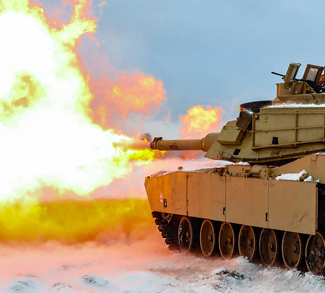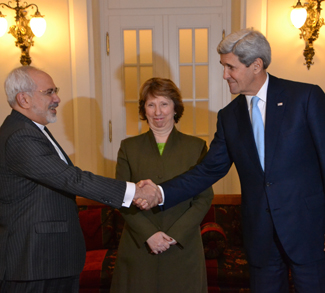During the Cold War and World War II (WW II), the world was safe because of deterrence. A balance of power existed between aligned nations cloaked in vibrant, robust militaries ready to defend their countries. The enemies of peaceful nations knew the costs, as President John F. Kennedy echoed that sentiment during his famous inaugural address about defending freedom and defeating foes. Those days are now gone, however, they can be revived again using deterrence that keeps worldwide war at bay.
We are living in treacherous times, and war could break out anywhere on the seven continents across the world. Our current predicaments are beginning to make the early 1930s look pale in comparison to what is happening today, because deterrence has been allowed to linger and stall since the collapse of the Soviet Union.
Collectively, we seem to have thought that history has stopped since the East and West German divide came down; but instead, we are witnessing a sharp upticks in wars, constant belligerence from the Middle East, the South China Sea dispute, and Mexico’s unending drug war. New threats are doing away with the resources to cope with refugee problems, the spread of terrorism, but most importantly the embrace of negative constructivism to resolve conflict.
Foreign Affairs magazine describe ten hotspots for 2017, or flashpoints globally that if not dealt with swiftly and even harshly could lead to war.Interestingly enough, Foreign Affairs didn’t mention China, North Korea, Russia or Iran. It can be argued that North Korea claiming they can fire an ICBM anytime and outgoing Secretary Kerry saying, “the U.S. may need more forceful ways of dealing with North Korea,” is a hotter spot than Ukraine.
Deterrence is the best answer for dealing with those nations. The type of deterrence at the forefront of the Cold War, which had far-reaching geopolitical implications, otherwise the future is cloaked in profoundly destabilizing actions by those four nations.
Gambling with the four above-mentioned nations without proper deterrence won’t work, but if done forcefully, then the other ten described foreign policy unknowns can be solved. If not, then jittery states from Europe to East Asia will begin to parse out safe real estate for their citizens if someone doesn’t step up. Historically that has been the United States (U.S.) since World War II. The U.S. structured a system based upon mutually agreed upon principles between major powers to keep World War III at bay.
Certainly that order has been was in flux recently, and disagreements rage about how this new discombobulating order began. There isn’t a correct answer. Moreover, add in the Rwanda genocide, the Yugoslavia breakup, and leaving Iraq after a brutal, tentative victory was achieved, and still there aren’t answers, which is the problem. But this cooperative, championed order, leading to unprecedented prosperity and peace, is suffering its share of dire crisis unless deterrence is restored. And Washington’s and NATO’s retrenchment is only leading to what will eventually see Japan, South Korea, and the Sunni coalition led by the Saudis join the nuclear club.
Let’s also not forget about India and Pakistan, who play a daily nuclear cat and mouse game in Kashmir. If Kashmir explodes, then does the U.S. intervene? China has an interest, and believes they can overtake India quickly. If China commits troops would other countries in the region follow suit? Another dangerous tightrope situation without a net while the basics of geopolitics continue forward wondering who will do the heavy lifting to sustain the international system.
Furthermore, will it be U.S. hard power or European soft power that restores deterrence? The perceived threats that the Iran nuclear deal were supposed to buffer haven’t kept the Islamic Republic from buying uranium and keeping oil prices low by taking advantage of OPEC’s weakness to boost their market share.
The Russians have seen fit to meddle in U.S., European, and former Soviet satellite elections at will while still threatening Ukraine. If Ukraine goes back to the Russians and out of NATO’s orbit then Europe will have to grow NATO and American troop presence more than it has in recent years.
The echoes of Russian aggression will have returned to Cold War levels, but it’s the correct move for deterrence to work, moving troops into Poland and Norway. The world wants peace, and this is a perfect example of military moves bolstering deterrence without a single shot being fired.
The European structure is being shaken as never before, and while some see a messy Brexit, that’s not what the facts say. Recently it was reported Britain has the number one growing advanced economy in the world. Yet what happens if Germany, the Netherlands and France leave the EU based upon these facts? Can the world afford to lose the European voice, its large economy, and its reliance upon soft power? Will Europe become splintered and fractured at best, and at worst, allow regional historical rivalries to return, sparking conflicts that could make the proxy wars taking place in Syria, Iraq and Yemen seem tame. The balance Europe brings can’t afford to be lost.
Here’s why the international system needs robust deterrence without war. Terrorism is the pretense of a common enemy, but that model can’t sustain itself. It is an illusion for nations to endlessly fight without a tactic to define a strategy. World War II was decisive, because there was a common, definable enemy that allowed for tactics and strategy leading to victory. Today’s terrorism fight has none of those modalities in place.
Thriving on chaos will not lead to building blocks for a stable future. This type of tactical bargaining has no long-term strategy or common values within their policies. Maybe a Turkish-Russian rapprochement holds promise, but historical enmity more than likely will win over long-term solutions being offered in Syria through this false promise. Considering Beijing’s war-like posture towards East Asia, the incoming Trump administration, Africa, and Latin America – what the world needs is overwhelming deterrence when dealing with China. Chaos can be managed, but only through deterrence.
Realpolitik and deal-making isn’t a guide to stable long-term solutions. Economic sanctions were crippling Iran until they were removed, and can work again if world powers have the vision to do what is necessary. That is a great example of soft power deterrence backed by hard power. Yet deals, like fluid relationships, can be broken, and our world is now made up of diverse states with globalized, vested interests. It can’t be stated enough that someone has to step up and keep the order with military-powered deterrence or with crippling economic sanctions to pull these nonstate actors and proxies off the world stage.
Many would say no single power could have singularity when it comes to controlling major powers or events. Manipulation can take place in the case of Libya when NATO, led somewhat by the U.S., bombed them into a fractured society. But real deterrence with military hard power had brought Gadhafi to his senses. He was working with the Americans, Europeans, and democratized Asian countries to denounce his nuclear program and terrorism. That only came about because he saw what happened to Saddam Hussein. That was lethal deterrence in force, and not a sanitized environment that brought Gadhafi to his senses.
Here’s what should immediately happen for deterrence to be restored. First, build a large, lethal blue-water navy, as the incoming U.S. administration is proposing. Iran, Russia, China, and North Korea have to be checked globally, and a fully equipped naval presence from freedom-loving nations accomplishes that task. Next, other NATO alliance members should follow the example of Norway, and their policy of burden sharing toward Europe’s collective defense. They pay their fair share when so many others don’t. NATO led by the U.S. has to demand every alliance member dedicates 2% of their budget to their military, which assists keeping the NATO alliance intact. Economically, push infrastructure and energy portfolios led by fossil fuel with renewables in the background while they overcome their problems.
If developing nations pushed natural gas as soft power deterrence, and worked on infrastructure bottlenecks delivering inexpensive natural gas from the Marcellus shale in the U.S. to exporting LNG across the globe then the most basic component of modern life – cheap, scalable energy – is secured. Nations that thrive economically are less willing to interrupt their prosperity with war and hostility towards other nations. Not every deterrence-issue has to have the big impact of a weapon to be effective.
No major, world power, such as the U.S., or China can single-handedly control world events. NATO, the U.S., the IMF, World Bank, and other post WW II conflict-negating entities can’t contain every fire, but with deterrence they can keep sparks from igniting into flames. Our globalized, messy world is now a fact, and deterrence is the best tool to keep our world from entering World War III.
The opinions, beliefs, and viewpoints expressed by the authors are theirs alone and don’t reflect any official position of Geopoliticalmonitor.com.




